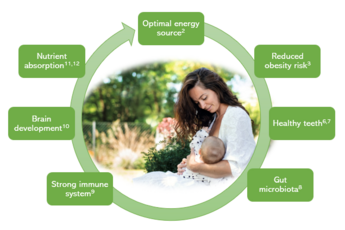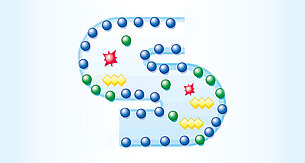Health Benefits of Naturally Occurring Sugars

Naturally occurring sugars vs added sugars
Naturally occurring sugars are found in milk (lactose) and fruit (fructose). Any product that contains milk (such as yogurt, milk or cream) or fruit (fresh, dried) contains some natural sugars.1
On the other hand, added sugars are sugars that are added to foods or drinks as ingredients during processing or preparation.
The naturally occurring sugar of breast milk is lactose, as well as in cow’s milk. In cow’s milk based formula, the naturally occurring sugar is also lactose.
However, some cow’s milk based formula use added sugars as caloric sweeteners or to totally replace lactose. Some examples of added sugars in cow’s milk based formula are sucrose, maltodextrin, fructose, corn syrup solids, and glucose syrup.
Comparison of naturally occurring sugar and commonly added sugars in cow’s milk-based formula
Sugar | Glycemic Index (GI) | Sweetness Index Score | Remarks |
Lactose | 45 | 16 | The natural sugar in breastmilk, composed of galactose and glucose |
Fructose | 23 | 110 | A natural sugar of fruit but added sugar if found in milk formula |
Sucrose | 65 | 100 | Main ingredient of table sugar, composed of glucose and fructose |
Corn Syrup | 100 | 30-40 | Short chains of glucose |
Corn Syrup Solids | 100 | 23-40 | Dehydrated corn syrup |
Maltodextrin | 110 | 6-21 | Longer, more complex glucose chains |
Glucose Syrup | 100 | 30-40 | Hydrolyzed starch commonly from corn |
Health Benefits of Lactose
1. Provides excellent, slow release energy source (GI=46)2
2. Supports in the prevention of childhood obesity3
Not addictive as it exerts no neurologically rewarding effects when ingested due to low sweetness index score4,5
3. The least cariogenic amongst fermentable sugars5,6
4. Contributes to early shaping of the neonatal intestinal microbiota7 that supports the immune function8
5. Galactose from Lactose plays a role as a structural building block for galactocerebroside, a lipid that plays a role in the myelin formation around the brain9
6. Known to enhance the absorption and retention of calcium, magnesium and manganese10,11
The Health Risks of Excessive Consumption of Added Sugars in Infants and Young Children
Higher levels of added sugar intake are associated with an increased risk of:
1. Dental caries12
2. Cardio-metabolic risk factors13
3. Asthma14
4. Elevated blood pressure15
5. Excess energy intake and poor diet quality16
6. Overweight17
7. Childhood Obesity considered the strongest risk factor to Type 2 Diabetes18
At HiPP, children are the focus of our attention by carefully selecting ingredients that are closest to nature. HiPP Organic Combiotic® contains only the natural milk sugar lactose and no added sugars. Give your child HiPP Organic Combiotic®. Help support your child’s health and development with organically sourced ingredients.
Reference:
1 https://www.heart.org/en/healthy-living/healthy-eating/eat-smart/sugar/sugar-101#:~:text=Naturally%20occurring%20sugars%20are%20found%20in%20milk%20(lactose)%20and%20fruit,dried)%20contains%20some%20natural%20sugars2 Gunnerud, U.; Holst, J.J.; Stman, E.; Björck, I. The glycemic, insulinemic and plasma amino acid responses to equi-carbohydrate milk meals, a pilot-study of bovine and human milk. Nutr. J. 2012, 11, 83.
3 Augustin, L.S.A.; Kendall, C.W.C.; Jenkins, D.J.A.; Willett, W.C.; Astrup, A.; Barclay, A.W.; Björck, I.; Brand-Miller, J.C.; Brighenti, F.; Buyken, A.E.; et al. Glycemic index, glycemic load and glycemic response: An International Scientific Consensus Summit from the International Carbohydrate Quality Consortium (ICQC). Nutr. Metab. Cardiovasc. Dis. 2015, 25, 795–815.
4 Schaafsma, G. Lactose and lactose derivatives as bioactive ingredients in human nutrition. Int. Dairy J. 2008, 18, 458–465.
5 Schaafsma, G. Lactose and lactose derivatives as bioactive ingredients in human nutrition. Int. Dairy J. 2008, 18, 458–465. Delaveau
6 P. Le lactose dans le lait; hypothese sur son importance biologique. Ann. Pharm. Fr. 2002, 61, 340–342.
7 Meurant, G. Handbook of Milk Composition, Chapter 4. Carbohydrates in Milks: Analysis, Quantities, and Significance. Food Sci. Technol. 1995, 6, 273–338.
8 Salzman, N.H.; Underwood, M.A.; Bevins, C.L. Paneth cells, defensins, and the commensal microbiota: A hypothesis on intimate interplay at the intestinal mucosa. Semin. Immunol. 2007, 19, 70–83.
9 Romero-Velarde E, Delgado-Franco D, García-Gutiérrez M, Gurrola-Díaz C, Larrosa-Haro A, Montijo-Barrios E, Muskiet FAJ, Vargas-Guerrero B, Geurts J. The Importance of Lactose in the Human Diet: Outcomes of a Mexican Consensus Meeting. Nutrients. 2019; 11(11):2737. doi.org/10.3390/nu11112737
10 Abrams, S.A.; Griffin, I.J.; Davila, P.M. Calcium and zinc absorption from lactose-containing and lactose-free infant formulas. Am. J. Clin. Nutr. 2002, 76, 442–446.
11 Ziegler E, et al. J. Pediatr Gastroenterol Nutr. 1983;2(2):288-294
12 Paglia L., Scaglioni S., Torchia V., De Cosmi V., Moretti M., Marzo G., Giuca M. Familial and dietary risk factors in Early Childhood Caries. Eur. J. Paediatr. Dent. 2016;17:93–99.
13 Vos M.B., Kaar J.L., Welsh J.A., Van Horn L.V., Feig D.I., Anderson C.A., Patel M.J., Cruz Munos J., Krebs N.F., Xanthakos S.A., et al. Added sugars and cardiovascular disease risk in children: A scientific statement from the american heart association. Circulation. 2017;135:e1017–e1034. doi: 10.1161/CIR.0000000000000439.
14 Park S., Blanck H.M., Sherry B., Jones S.E., Pan L. Regular-soda intake independent of weight status is associated with asthma among US high school students. J. Acad. Nutr. Diet. 2013;113:106–111. doi: 10.1016/j.jand.2012.09.020.
15 Kell K.P., Cardel M.I., Brown M.M., Fernández J.R. Added sugars in the diet are positively associated with diastolic blood pressure and triglycerides in children. Am. J. Clin. Nutr. 2014;100:46–52. doi: 10.3945/ajcn.113.076505.
16 Magriplis E., Michas G., Petridi E., Chrousos G.P., Roma E., Benetou V., Cholopoulos N., Micha R., Panagiotakos D., Zampelas A. Dietary sugar intake and its association with obesity in children and adolescents. Children. 2021;8:676. doi: 10.3390/children8080676.
17 Herrick K.A., Fryar C.D., Hamner H.C., Park S., Ogden C.L. Added Sugars Intake among US Infants and Toddlers. J. Acad. Nutr. Diet. 2020;120:23–32. doi: 10.1016/j.jand.2019.09.007.
18 Belkina AC, Denis GV. Obesity genes and insulin resistance. Curr Opin Endocrinol Diabetes Obes. 2010;17(5):472–477.




